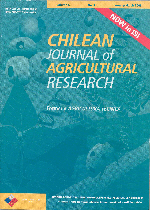
|
Agricultura Técnica
Instituto de Investigaciones Agropecuarias, INIA
ISSN: 0365-2807
EISSN: 0365-2807
Vol. 66, No. 1, 2006, pp. 21-30
|
 Bioline Code: at06003
Bioline Code: at06003
Full paper language: Spanish
Document type: Research Article
Document available free of charge
|
|
|
Agricultura Técnica, Vol. 66, No. 1, 2006, pp. 21-30
| es |
Efectividad de extractos botánicos de diez plantas sobre la mortalidad y repelencia de larvas de Rhynchophorus palmarum  L., insecto plaga del pijuayo Bactris gasipaes L., insecto plaga del pijuayo Bactris gasipaes  Kunth en la Amazonía del Perú Kunth en la Amazonía del Perú
Perez, Diana D. & Iannacone, José O.
Resumen
La resistencia de las plagas a los insecticidas químicos se ha incrementado en los últimos años, motivo por el que se buscan métodos alternativos, como extractos de plantas con actividad larvicida. El objetivo del presente trabajo fue evaluar el efecto sobre la mortalidad y repelencia de larvas de Rhynchophorus palmarum

L. (Curculionidae), plaga del pijuayo Bactris gasipaes

Kunth, de diez plantas con potencial biocida: ucullucuysacha ( Heliotropium indicum

L., Boraginaceae), floripondio ( Brugmansia sp., Solanaceae), oreja de tigre ( Tradescantia zebrina

Hort. ex Bosse, Commelinaceae), piñon blanco ( Jathropa curcas

L., Euphorbiaceae), sacha yoco ( Paullinia clavigera

Schltdl., Sapindaceae), yuquilla ( Euphorbia cotinifolia

L., Euphorbiaceae), achiote ( Bixa orellana

L., Bixaceae), retama común ( Cassia fistula

L., Fabaceae), huancahuisacha ( Aristolochia pilosa

Kunth, Aristolochiaceae) y curare ( Chondrodendron tomentosum

Ruiz & Pavon, Menispermaceae). Los bioensayos con R. palmarum se realizaron a 1, 4, 8, 12 y 24 h, usando 660 larvas bajo condiciones de laboratorio, empleando extractos botánicos acuosos mayormente a la proporción 1:3 (p/v). A 24 h de exposición, los mayores porcentajes de mortalidad de R. palmarum se presentaron con huancahuisacha (73,30%: hojas y tallo licuados), oreja de tigre (70%: hojas y tallo licuados) y curare (60%: madera y corteza en decocción). En el caso de la repelencia, los mayores efectos se encontraron para huancahuisacha (80%), curare (73,30%) y oreja de tigre (71,70%). En adición, piñon blanco (semillas licuadas) produjó sólo 3,3% de mortalidad y significativamente un 55% de repelencia. Se analizan las posibilidades de empleo de estos extractos botánicos en el manejo integrado de R. palmarum.
Aristolochia pilosa, Bactris gasipaes, Bixa orellana, Brugmansia, Cassia fistula, Chondrodendron tomentosum, Euphorbia cotinifolia, Heliotropium indicum, insecticidas botánicos, Jathropa curcas, mortalidad, Paullinia clavigera, Perú, repelencia, Rhynchoporus palmarum, Tradescantia zebrina, etnobotánica.
|
| |
| en |
Effectiveness of botanical extracts from ten plants on mortality and larval repellency of Rhynchophorus palmarum  L., an insect pest of the Peach palm Bactris gasipaes L., an insect pest of the Peach palm Bactris gasipaes  Kunth in Amazonian Peru Kunth in Amazonian Peru
Perez, Diana D. & Iannacone, José O.
Abstract
Pest resistance to chemical insecticides has grown in recent years, which is the motive for the search for alternative methods, such as plants with larvicidal activity. The objective of this research was to evaluate mortality and larval repellency of Rhynchophorus palmarum

L. (Curculionidae), a pest of the Peach palm Bactris gasipaes

Kunth to ten plants with biocide potential: india heliotrope ( Heliotropium indicum

L., Boraginaceae), angels' trumpets ( Brugmansia sp., Solanaceae), wandering jew ( Tradescantia zebrina

Hort. ex Bosse, Commelinaceae), nettles-purge ( Jathropa curcas

L., Euphorbiaceae), soapberry ( Paullinia clavigera

Schltdl., Sapindaceae), red spurge ( Euphorbia cotinifolia

L., Euphorbiaceae), annato ( Bixa orellana

, Bixaceae), golden shower ( Cassia fistula

L., Fabaceae), birthwort fruit ( Aristolochia pilosa

Kunth, Aristolochiaceae) and pareira ( Chondrodendron tomentosum

Ruiz & Pavon, Menispermaceae). Bioassays with R. palmarum were performed at 1, 4, 8, 12 and 24 h exposure, employing 660 larvae under laboratory conditions and aqueous botanical extracts of the plants at a 1:3 (w/v) ratio. At 24 h exposure, the highest mortality percentage of R. palmarum was observed with birthwort fruit (73.30%: liquefied leaves and stems), wandering jew (70%: liquefied leaves and stems) and pareira (60%: wood and bark in decoction). In the case of repellency, the highest effects were found in birthwort fruit (80%), pareira (73.30%) and wandering jew (71.70%). In addition, nettles-purge (liquefied seeds) produced only 3.3% mortality but significantly 55% repellency. The possibility of employing these botanical extracts in integrated management of R. palmarum is analyzed.
Aristolochia pilosa, Bactris gasipaes, Bixa orellana, botanical insecticides, Brugmansia, Cassia fistula, Chondrodendron tomentosum, Euphorbia cotinifolia, Heliotropium indicum, Jathropa curcas, mortality, Paullinia clavigera, Peru, repellency, Rhynchoporus palmarum, Tradescantia zebrina, ethnobotanical.
|
| |
© Copyright 2006 - Instituto de Investigaciones Agropecuarias, INIA (Chile).
Alternative site location: http://www.inia.cl/at/agritec.htm
|
|
